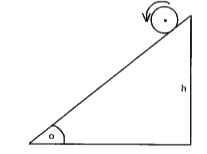Prove the result that the velocity u of translation of a rolling body (like a ring, disc, cylinder or sphere) at the bottom of an inclined plane of a height h is given by
u2=2ˆgh(1+k2/R2) using dynamical consideration (i.e by consideration of forces and torques). Note k is the radius of gyration of the body about its symmetry axis, and R is the radius of the body. The body starts from rest at the top of the plane.
When a body rolls down an incline of height h, we apply the principle of conservationof energy.

K.E of transtation + K.E of rotation
= P.E at the top
i.e. 12mv2+12Iw2=mgh
12mv2+12(mk2)w2=mgh
As w=VR
∴12mv2+12mk2R2v2=mgh
or 12mv2(1+K2R2)=mgh
v2=2gh(1+K2R2)
Similar Questions
Prove the result that the velocity v of translation of a rolling body (like a ring, disc, cylinder or sphere) at the bottom of an inclined plane of a height h is given by v2=2gh(1+k2/R2) using dynamical consideration (i.e. by consideration of forces and torque). Note k is the radius of gyration of the body about its symmetry axis, and R is the radius of the body. The body starts from rest at the top of the plane.
View SolutionProve the result that the velocity v of translation of a rolling body (like a ring, disc, cylinder or sphere) at the bottom of an inclied plane of a hight h is given by v2=2gh(1+k2/R2) using dynamical consideration (i.e. by consideration of forces and torque). Note k i sthe radius of gyration of the body about its symmentry axis, and R is the radius of the body. The body starts from rest at the top of the plane.
View Solution
Knowledge Check
- Question 1 - Select One
If R is the radius of gyration of a body of mass M and radius r, then the ratio of its rotational to translational kinetic energy in the rolling condition is
AR2R2+r2BR2r2Cr2R2D1 - Question 2 - Select One
A body rolls without slipping. The radius of gyration of the body about an axis passing through its centre of mass is K. The radius of the body is R. The ratio of rotational kinetic energy to translational kinetic energy is.
AK2R2BR2K2+R2CK2K2+R2DK2+R2 - Question 3 - Select One
Radius of gyration of a body an axis is 1 cm. Radius of gyration of the same body about a parallel axis passing through its centre of gravity is 2 cm. then perpendicular distance between the two axes is
A√3cmB1 cmC4 cmD1.5 cm
The radius of gyration of a disc about its own axis is is R√2 The radius of gyration about its diameter is- - - - -
View SolutionIf R is the radius of gyration of a body of mass M and radius r, then the ratio of its rotational to translational kinetic energy in the rolling condition is
View SolutionStatement-1 : Radius of gyration of a body is a constant quantity.
Statement-2 : The radius of gyration of a body about an axis of rotation may be defined as the root mean square distance of the particles of the body from the axis of rotation.View SolutionIf a ring, a disc, a solid sphere and a cyclinder of same radius roll down an inclined plane, the first one to reach the bottom will be:
View SolutionIf a ring, a disc, a solid sphere and a cyclinder of same radius roll down an inclined plane, the first one to reach the bottom will be:
View Solution
